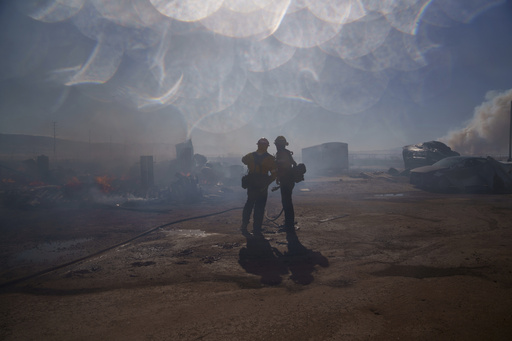LOS ANGELES (AP) — Firefighters increased their containment of a large wildfire in mountains north of Los Angeles on Monday after a weekend of explosive, wind-driven growth along Interstate 5.
The Post Fire was 8% surrounded after scorching more than 24 square miles (61 square kilometers) and forcing the evacuation of at least 1,200 campers, off-roaders and hikers from the Hungry Valley recreation area on Saturday.
“That 8% is good because it means we are increasing and bolstering our containment lines,” said Kenichi Haskett, a Los Angeles County Fire Department section chief.
Firefighters hoped to hold the fire at its current size, but further growth was still possible, especially towards the south, Haskett said.
The fire broke out as weather turned hot and windy in a region where grasses spawned by a rainy winter have long since dried out and easily burn.
The massive columns of smoke that marked the fire’s initial rampage were gone by Monday morning. But Sunday’s smoke drifted some 225 miles (360 kilometers) northwest across the Mojave Desert to cast a slight haze in the Las Vegas area. Nevada air quality officials issued an alert advising children, older adults, and people with respiratory and heart disease to stay indoors.
In Northern California, a wildfire sparked Sunday prompted evacuation orders and warnings for a sparsely populated area near Lake Sonoma. Known as the Point Fire, it was 20% surrounded Monday after charring nearly 2 square miles (5 square kilometers) about 80 miles (130 kilometers) north of San Francisco, and destroyed at least one structure.
Ben Nicholls, division chief of the Cal Fire district in area covering the Point fire, said Monday morning that fire activity subsided overnight.
“Forecasted winds are supposed to be less than we experienced yesterday, which should allow the resources assigned for this operational period to build and strengthen the control lines that were put in place yesterday,” Nicholls said in a video briefing.
The Southern California fire erupted Saturday afternoon near I-5 in Gorman, about 60 miles (100 kilometers) northwest of Los Angeles. Two structures burned within the evacuated recreation area.
The majority of the 1,148 firefighters assigned to the blaze were focused on its southern edge, near popular Pyramid Lake, which was closed as a precaution on Father’s Day and again Monday. Officials also warned residents of Castaic, home to about 19,000 people, that they should prepare to leave if the fire pushed farther south.
“If you’re in a warning area, be prepared with a ‘go bag,’ with overnight clothes and your cellphone, your medicines, your glasses. Have your car fueled up,” said Haskett. “Be ready to evacuate.”
About 75 miles (120 kilometers) to the east, the nearly 2-square-mile (5-square-kilometer) Hesperia Fire was 30% contained after no overnight growth. The fire erupted Saturday and forced road closures and evacuation warnings in San Bernardino County.
After back-to-back wet winters, fire season has gotten off to a slow to near-average start, said Daniel Swain, a climate scientist with the University of California, Los Angeles.
“These are not peak season fires either in scope or behavior, or in terms of where they’re burning,” Swain said in an online briefing. “In many ways, they’re classic, early-season fires since they’re primarily burning in grass and brush.”
Swain said he expects more fire activity to begin in July at lower elevations and August at higher elevations.
“And the bad news is that I think that the back half of this season is going to be much more active, with a lot more concerning level of wildfire activity in a lot of areas than the first half,” he said.



